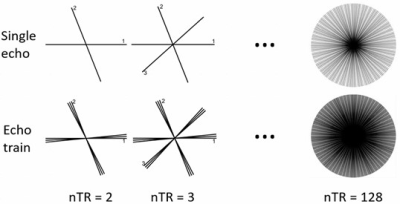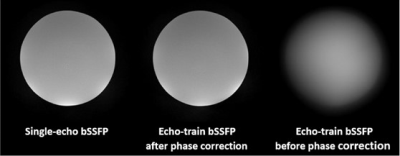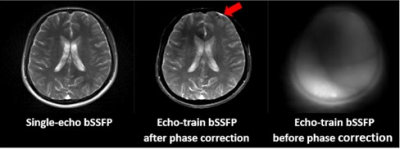0840
Echo-train bSSFP for Rapid Golden-angle Radial Sampling1Center for MR Research, University of Illinois at Chicago, Chicago, IL, United States, 2Department of Bioengineering, University of Illinois at Chicago, Chicago, IL, United States, 3Departments of Radiology and Neurosurgery, University of Illinois at Chicago, Chicago, IL, United States
Synopsis
Golden-angle radial sampling based on single-echo bSSFP has been increasingly used in MRI. In a method known as ETGAR (echo-train golden-angle radial), a series of spokes separated by a golden angle are acquired within a TR to accelerate data sampling. A main disadvantage is that the large inter-echo steering gradients can lead to a longer TR and trigger eddy currents. We herein demonstrate an alternative golden-angle radial sequence – ETGAR-II – to overcome the afore-mentioned issues. This novel sequence, together with an integrated phase-correction algorithm has been demonstrated on phantoms and human to obtain high quality images with 36% scan time reduction.
Introduction:
Golden-angle radial sampling has been increasingly used in MRI, particularly for dynamic imaging studies. This technique utilizes continuous data acquisition and retrospective reconstruction to provide a flexible temporal resolution1–4. Image acquisition typically relies on a single-echo balanced steady-state free precession (bSSFP) sequence which offers a high signal-to-noise ratio (SNR) efficiency1. Despite many advantages of this implementation, the single-echo approach of producing one spoke per TR can impose a limitation on temporal resolution. In a technique known as ETGAR (echo-train golden-angle radial) sampling5, a series of spokes separated by a golden angle within the same TR were acquired to accelerate data sampling. An obvious disadvantage is that the large inter-echo steering gradient pulses can lead to a longer TR, thus compromising the temporal resolution. To address this issue and avoid large steering gradient pulses that may trigger additional eddy currents, we herein report a novel k-space filling strategy that also satisfies the golden-angle sampling requirement. We call this sequence ETGAR-II. The use of an echo train to increase the number of spokes per TR may elevate sensitivity to eddy currents due to gradient switching. This issue has been addressed by incorporating a systematic phase correction algorithm into image reconstruction.Methods:
Pulse sequence: ETGAR-II employs a train of gradient echoes separated by steering blip gradient pulses, which orient adjacent k-space lines within a TR by a small fixed angle ϕ (defined later). Figure 1 shows three readout gradients in an echo train (a) and the corresponding radial k-space lines (b) color-coded with blue, yellow, and green. The red and purple blip gradients between the adjacent gradient echoes are “steering” pulses, which are used to steer the k-space trajectory6. The brown gradients at the end of the echo train rewind the phase along the kx- and ky-directions, as required by bSSFP. To generate the remaining sets of k-space lines in subsequent TRs, the rotation matrix of the scanner was employed with a rotation angle equal to the golden angle θ (111.24…°) per TR.k-space sampling: The angle of the jth k-space line can be calculated by the following equation:
$$Φ(j) = MOD(j-1,ETL)×\phi+QUO(j-1,ETL)×\theta,$$
where QUO and MOD represent the calculations of quotient and remainder, respectively. ETL is echo train length per TR. Simulations of radial sampling with ϕ of 180°/64.0, θ of 111.24…°, and ETL of 3 were performed for different number of TRs (nTR; Figure 2). Six different gap sizes between adjacent k-space lines were found, and no overlap was detected among the 384 lines in 128 TRs. For comparison, the simulation results for the single-echo acquisition are also shown in Figure 2.
Phase corrections: Correction of two types of phase errors – inter-echo and inter-shot phase errors – was incorporated into image reconstruction (Figure 3). Inter-echo phase errors occur among the echoes in the echo train within a TR. Inter-shot phase errors arise between the spokes acquired in different TRs, which can be caused by motion or eddy currents with a long time constant. The central k-space region with over sampling was used to perform both inter-echo and inter-shot phase error corrections. After phase corrections, image reconstruction was performed by re-gridding, density compensation, and FFT.
Experimental studies: The ETGAR-II sequence was implemented on a GE MR750 3T scanner and evaluated on phantoms and healthy human brains using an 8-channel head coil. For both phantom and brain scans, axial images were acquired with the following parameters: FOV = 24x24cm2, matrix size = 256x256, slice thickness = 5mm, number of spokes = 384, ETL = 3, BW = ±125kHz, TR = 10ms, and TEs = 2.3/4.3/6.3ms. For comparison, images were also acquired with a radial single-echo bSSFP sequence using the same parameters except for TR/TE = 5.2/2.1ms.
Results:
The phantom images obtained using single-echo bSSFP and ETGAR-II bSSFP are displayed in Figure 4. The phase correction strategy effectively removed the image artifacts, resulting in considerably improved image quality. Compared with single-echo bSSFP (SNR = 99.3), ETGAR-II produced comparable image quality (SNR = 80.2). The moderate SNR reduction in ETGAR-II was a reflection of increased average TE and decreased scan time. The brain images acquired with the two sequences are shown in Figure 5. With ETGAR-II bSSFP, the scan time was reduced by 36% without a noticeable reduction in image quality as compared to single-echo bSSFP. The susceptibility/banding artifacts were slightly elevated in the frontal area due to the increased sensitivity to off-resonance in echo-train acquisitions.Discussion and conclusion:
We have demonstrated a new strategy to sample radial k-space using an echo train while satisfying the golden angle requirement in bSSFP without using large or long steer gradient pulses. Compared to single-echo acquisition, the new strategy with multiple k-space spokes per TR can reduce the scan time by 36% without noticeably compromising the image quality. We have also shown that an integrated phase correction algorithm can effectively remove both inter-echo and inter-shot phase errors. These technical developments paved the way of using this time-efficient echo-train golden-angle radial bSSFP pulse sequence to explore applications that require high temporal resolution.Acknowledgements
This work was supported in part by the National Institutes of Health (5R01EB026716-01 and 1S10RR028898-01). The content is solely the responsibility of the authors and does not necessarily represent the official views of the National Institutes of Health. The authors are grateful to Dr. Muge Karaman, Dr. Qingfei Luo, and Guangyu Dan for helpful discussions.References
1. Winkelmann S, Schaeffter T, Koehler T, et al. An optimal radial profile order based on the golden ratio for time-resolved MRI. IEEE Trans. Med. Imaging 2007.
2. Usman M, Atkinson D, Odille F, et al. Motion corrected compressed sensing for free-breathing dynamic cardiac MRI. Magn. Reson. Med. 2013.
3. Ehses P, Seiberlich N, Ma D, et al. IR TrueFISP with a golden-ratio-based radial readout: Fast quantification of T1, T2, and proton density. Magn. Reson. Med. 2013.
4. Hopfgartner AJ, Tymofiyeva O, Ehses P, et al. Dynamic MRI of the TMJ under physical load. Dentomaxillofacial Radiol. 2013.
5. Sun K, Zhong Z, Zhou XJ. Echo-train radial SSFP with golden angle. ISMRM 2020; p. 610.
6. Srinivasan G, Rangwala N, Zhou XJ. Steer-PROP: a GRASE-PROPELLER sequence with interecho steering gradient pulses. Magn. Reson. Med. 2018.
Figures




